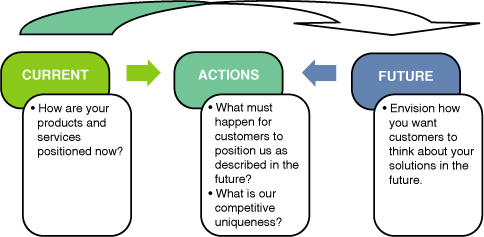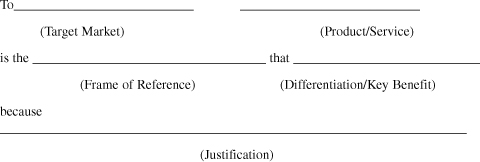43. Positioning Strategy
The value proposition, positioning statement, and brand identity are three elements at the heart of your marketing plan. Everything you have learned about brand differentiation must now be expressed creatively in your marketing communication programs through these three elements. As Lynn Upshaw, author of Building Brand Identity, states so eloquently, positioning sets the direction for all further marketing activity:
“A brand’s positioning is the compass of its identity, pointing it toward the place where it can leverage the most power in the category in which it competes, and establish the most powerful leverage within the lives of its potential users. How a brand is recognized in the marketplace is based largely on its personality, but what it means in someone’s life is derived from its positioning.”
Positioning is a term used to describe how customers perceive a product when considering all the competitive alternatives to choose from in a product category. It is the distinct position of your products and services in the mind of your prospective customers. It is not a tag line or a slogan, but a carefully crafted statement that defines the key benefit you would like targeted customers to think of given all the other choices available in the market. The most critical element of a positioning statement is differentiation. A brand cannot be created unless it is differentiated in the market.
In a moment, you will learn how to write a positioning statement that will focus and articulate the unique benefits and differentiation of your solution to targeted customers. This statement will be used in every aspect of your marketing, including collateral, advertising, and promotion—essentially every message and channel in which you communicate.
Types of Positioning
First, let’s look at different ways you can position your solution. There are six primary positioning methods that describe the most common types of positioning strategy for a product or service:
• Positioning by attribute, which the automobile industry clearly demonstrates. BMW stresses handling and engineering efficiency; Volvo emphasizes safety and durability; Volkswagon emphasizes practicality.
• Positioning by price or quality, which is how consumers distinguish between a low-price leader like Wal-Mart and a high-end retailer like Neiman Marcus.
• Positioning with respect to use or application, such as Johnson & Johnson did with baby shampoo. They repositioned the product for people who wash their hair frequently and wanted a mild shampoo, increasing market share from 3 percent to 14 percent.
• Positioning by the product user to deliver a target message, such as “Choosy Mothers Choose Jif.”
• Positioning with respect to a competitor, as Avis famously did with the “We’re #2 So We Try Harder” campaign.
• Positioning by problem, which is targeting a product or service as a solution to solve a specific problem. An example is Federal Express: “When it absolutely, positively has to be there overnight.”
As you begin the process of developing your positioning statement, answer the following questions (see Figure 43.1):
• How are your products and services positioned now? Examine your current marketing materials and advertising messages.
• How do you want your target customers to think about and position your products and services in the future?
• What actions must you take to get from your current position to what you envision for your brand?
• How is this position different or better than your competitors?

Figure 43.1 Positioning your brand
Positioning statements are comprised of five elements: target market, product/service identification, frame of reference, point of difference or uniqueness, and justification for the uniqueness. Except for two, most of the elements are obvious. A product’s frame of reference refers to the options your target market has available to them to fulfill a specific need. While it is important to narrow focus on a specific target market, it is usually (but not always) best to expand the frame of reference because you want to include possible substitutes. For example, if the product was an iPod, the frame of reference may be “portable music devices.”
Differentiation is the attribute that sets your product apart from all others. It refers to the one specific benefit (two at the most) that you want people to associate with your solution. It’s tempting to say, “Yes, but my product does X, Y, and Z”—but if you try to communicate more than one or two benefits, it will only confuse a prospective customer and the product will be dropped completely out of mind. Differentiation is the key to positioning and branding.
The last element in the positioning statement is justification, and this is the evidence or facts that back up the promised results. This needs to be a fact, not wishful thinking or an opinion. It is a fact that gives the buyer justification for why your solution is better.
Create a Positioning Statement
Now write a positioning statement for your solution. If possible, do this with your marketing team to brainstorm all the possible options to arrive at the best possible outcome. The draft wording of your positioning statement may seem a bit contrived, but remember it is not intended to be used literally in a tag line or messaging. It is meant to be used internally (and shared with agencies and consultants who develop marketing materials) to guide and focus your messaging and strategies.

Example Positioning Statements
Federal Express:
To deadline-oriented business people, Federal Express is the overnight package delivery service that is the most reliable because of its sophisticated package tracking system.
Clinic Service Corporation:
To physician’s office administrators who manage an office with 4–8 physicians, Clinic Service Corporation is the medical billing company that provides intimate, personalized customer care for every client while delivering industry leading ROI and profitability to physicians because we collect 99.7 percent of total billed revenue.
Positioning is a key component of brand equity. Strong positioning infers differentiation which leads to the ability to command a higher price. Higher prices should translate to higher profits, which is the reward for differentiating your product from competitors.
The outcome of a positioning statement is a value proposition that is a simple and concise statement of the benefits for your targeted customer. For example:
• Volvo: The safe, durable car for your family.
• Geiko: The money you could be saving.
• DiGiorno: It’s not delivery. It’s DiGiorno.
• Southwest Airlines: The no-frills, low-cost, fun airline.
Several factors ultimately influence a brand image. Companies like Ben and Jerry’s, The Body Shop, Starbucks, and Apple have very strong brands that are linked to social responsibility and innovation. What makes the brands unique and memorable is consistency of messaging across integrated marketing programs.
Another factor is uniqueness of position in the marketplace. For example, Starbucks CEO Howard Schultz believes the quality of the company’s work force is their “only sustainable competitive advantage.” Starbucks’ relentless focus on employees is visible in the ground-breaking health insurance plan for part-time employees and in the way employees are trained. Even though the company has grown from a small coffee shop in Seattle to one of the world’s most recognizable brands, the company has maintained a culture that is hard for even mom and pop coffee shops to imitate.
